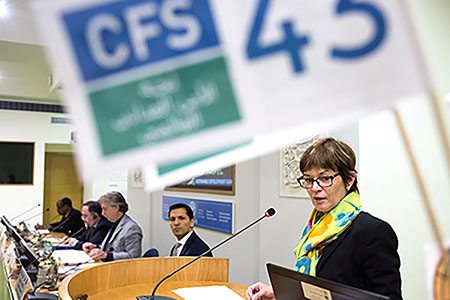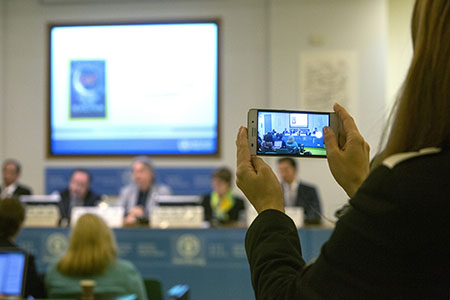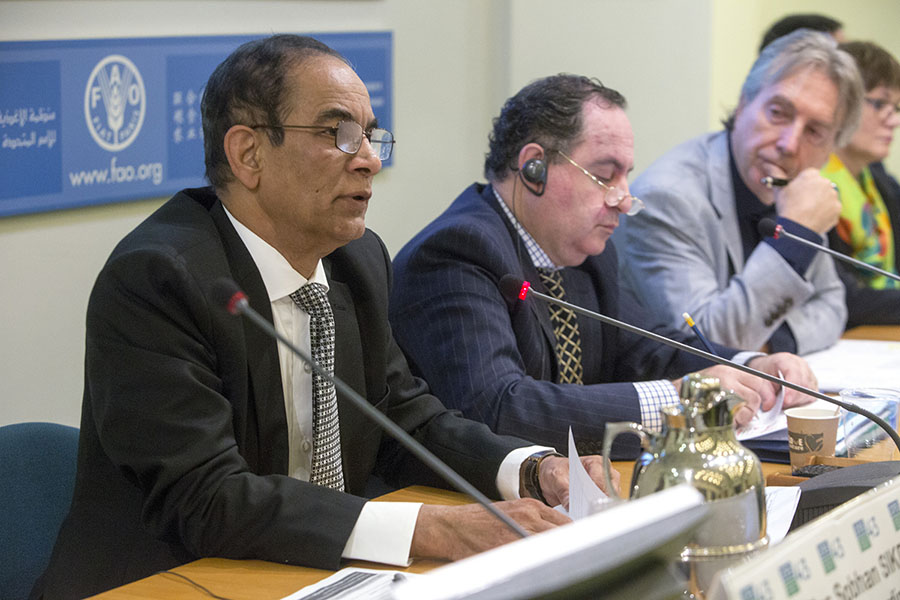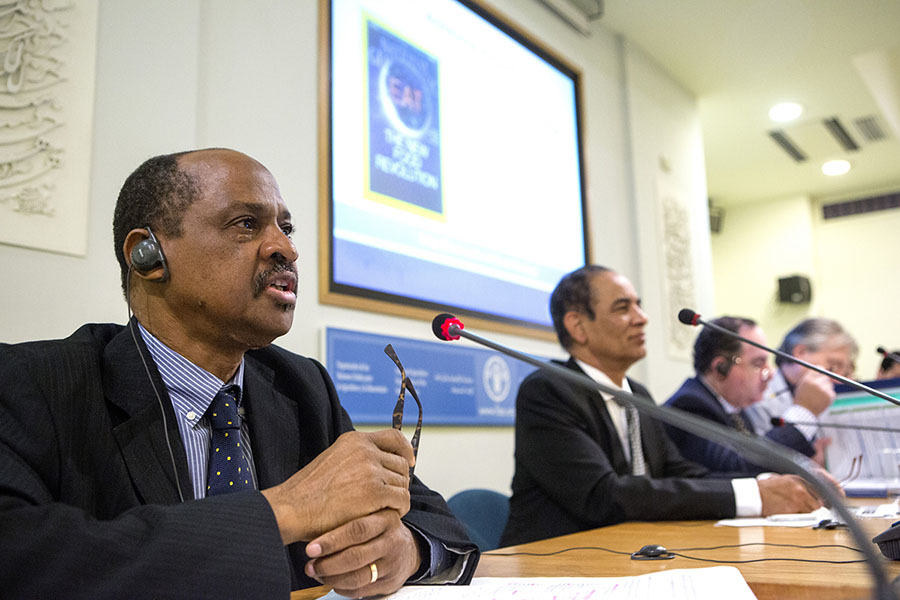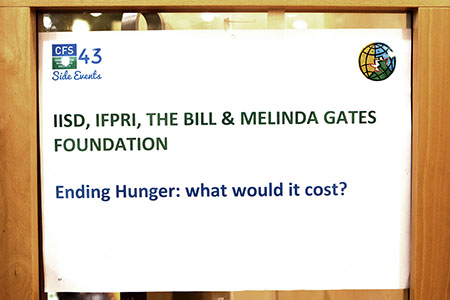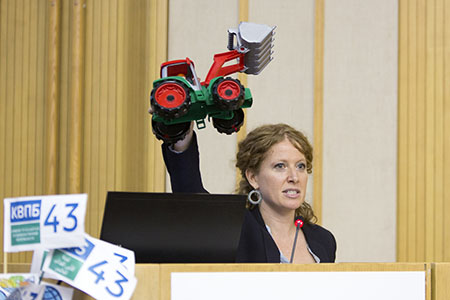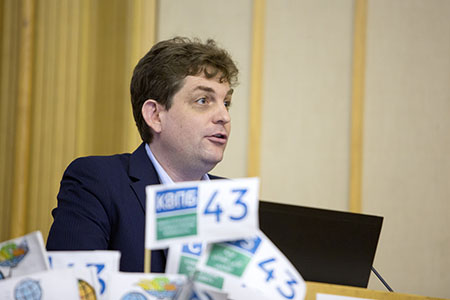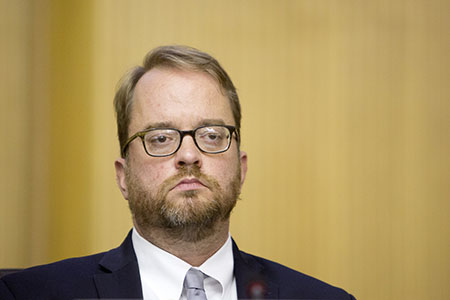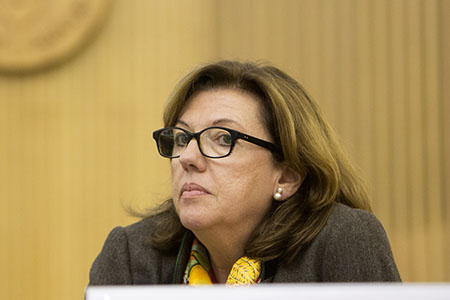Summary
The following side events were covered by ENBOTS on Friday, 21 October 2016:
- Bridging Global Policy Agreements and Country Achievements of the SDGs: The Key Role of Regions for Achieving and Reviewing Progress on Food Security and Nutrition
- Ending Hunger: What Would It Cost?
IISD Reporting Services, through its ENB+ Meeting Coverage, has provided web coverage of CFS 43 and selected side-events. The summary report of CFS 43 is available in HTML and PDF.
Bridging Global Policy Agreements and Country Achievements of the SDGs: The Key Role of Regions for Achieving and Reviewing Progress on Food Security and Nutrition
Organized by FAO, WHO, Argentina, Bangladesh, Egypt, African Union.
This side event, moderated by Rob Vos, FAO, focused on how different governments and regional bodies prioritize food security and nutrition policy in the context of the 2030 Agenda for Sustainable Development. Vos said that progress had been made and the number of people facing malnourishment has fallen, but based on current trends it will be a challenge to meet the 2030 Agenda goals. He added that regional frameworks and experiences can contribute to policy and actions to eradicate hunger and malnutrition.
Mazella Wüstefeld, WHO, presented on the multiple burden of malnutrition – undernutrition, obesity and non-communicable diseases (NDCs) – and monitoring progress of 2030 Agenda goals. Malnutrition, she said, is the number one risk factor in the global burden of diseases, and to improve nutrition, food systems need to be improved. Good nutrition, she added, is a core element of the SDGs, particularly SDG2, and policy coherence and action at scale in a concrete time frame are needed. In addition to the targets set out in Agenda 2030, she also highlighted WHO’s 2025 six global nutrition targets: 40% reduction in the number of children under five who are stunted; 50% reduction of anemia in women of reproductive age; 30% reduction in low birth weight; no increase in childhood overweight; increase the rate of exclusive breastfeeding in the first six months up to at least 50%; and reduce and maintain childhood wasting to less than 5%.
Haladou Salha, African Union-NEPAD, highlighted Africa’s Agenda 2063, a strategic framework for the socioeconomic transformation of the continent over the next 50 years. He said that Africa 2063 complements the 2030 Agenda, with 90% of the SDGs already enshrined in the African vision. He added that the 2014 Malabo Declaration of African Heads of State has further inspired the continent’s efforts to improve food productivity and eradicate hunger and malnutrition. Salha announced the establishment of a NEPAD-housed knowledge hub to help countries share their experiences on food security.
Khaled El Taweel, Alternate Permanent Representative of Egypt to FAO, presented on Egypt Vision 2030, the country’s new national sustainable development strategy. He noted that the plan was adopted prior to the 2030 Agenda, but that many of the goals are aligned. El Taweel highlighted a school meals programme and a plan to reclaim agriculture land to increase productivity, both aimed at tackling malnutrition and food security.
Claudio Rozencwaig, Permanent Representative of Argentina to FAO, noted that regional plans, including the 2005 Zero Hunger initiative, the 2015 CELAC Plan for Food Security, Nutrition and Hunger Eradication and others, have contribute to reducing malnutrition throughout Latin America and the Caribbean. He stressed that regional agreements have been critical in achieving results, noting a regional decline in malnutrition from 59 million in the 1990s to 47 million in 2013. Political commitment, he added, has been an important part of the success.
Abus Sobhan Sikder, Permanent Representative of Bangladesh to FAO, presented on his country’s development goals, highlighting Vision 2021, which aims at transforming Bangladesh into a middle-income country by 2021. He said that Bangladesh had reached the MDG of halving the proportion of living below the poverty line – from 57% in 1991 to 24% in 2015 – thanks to the enactment of a comprehensive National Food Policy framework. He stressed that improving food security and inclusive development are at the top of the political agenda, and that more work needs to be done to balance diets and improve food storage and distribution capacity.
Mazella Wüstefeld, WHO
©FAO
©FAO
Abus Sobhan Sikder, Permanent Representative of Bangladesh to FAO
©FAO
Haladou Salha, African Union-NEPAD
©FAO
Contacts:
-
Areej Jafar, FAO, areej.jafari@fao.com
More Information:
Ending Hunger: What Would It Cost?
Organized by the International Institute for Sustainable Development (IISD), International Food Policy Research Institute (IFPRI), The Bill & Melinda Gates Foundation.
This side event, moderated by Carin Smaller, IISD, focused on smarter, well-targeted, bottom-up interventions to solve the hunger problem. She said ending hunger is achievable and affordable, noting five categories where targeted spending needs to take place: social safety nets, farm support, rural development, enabling policies and nutrition. The model, she noted, did not cost nutrition interventions because the household dataset used had limited coverage on micronutrient availability.
David Laborde, International Food Policy Research Institute (IFPRI), presented on an IISD-IFPRI multi-country macroeconomic model study that analyzes information obtained from household surveys, and matches them with donor priorities to build a case for establishing feasible targets for donors; the surveys were conducted in Senegal, Ghana, Nigeria, Uganda, Tanzania, Malawi and Zambia. Laborde said to end hunger – defined as 95% of a population able to consume 1,750 calories a day –would cost on average US$11 billion per year of public spending from now until 2030, with US$4 billion of that coming from donors. He added that to reach the target, direct interventions are needed, including food stamps for households, capital investment and technology for farmers, and rural infrastructure development and education; noting that interventions should deliver the bulk of the pay-off by 2030.
Njama Nango Dembélé, Minister for Livestock and Fisheries, Mali, noted that his government has earmarked 15% of the national budget for the next few years to the agriculture sector, which contributes not only to job creation, but also sustainable development and food security. He added that his ministry has departments dedicated to providing safety nets to the most vulnerable populations. He said that, although progress has been made in his country in achieving food security, more needs to be done, especially in urban areas.
Laura Frigenti, Italian Agency for Development Cooperation, stressed that to maximize efficiency in public spending to achieve better results it is important to prioritize areas, especially as there may not be enough money to fund all the SDGs. This, she said, helps donors better target limited resources. She added that it is also important to make sure there are systems in place to ensure that funding goes to the beneficiaries, and that there are mechanisms in place to evaluate the investments during the process, not just at the end.
Neil Watkins, Bill & Melinda Gates Foundation, said the model, which uses household data, is innovative and can help with targeting, particularly as it focuses on just one aspect of SDG 2 – caloric hunger. While it is important to segment the issue for a more in-depth analysis, he noted that a comprehensive approach is also needed. He added that even if the amount proposed is ambitious, political will is needed to reach those funding levels.
In discussions, participants considered, inter alia, the need for better targeting, the lack of focus on nutrition and sustainable development, the distinction between technical feasibility and political will, and concerns over the aim to reduce hunger to a 5% threshold and not ending it completely.
©FAO
Carin Smaller, IISD
©FAO
David Laborde, International Food Policy Research Institute (IFPRI)
©FAO
Njama Nango Dembélé, Minister for Livestock and Fisheries, Mali
©FAO
Neil Watkins, Bill & Melinda Gates Foundation
©FAO
Laura Frigenti, Italian Agency for Development Cooperation
©FAO
Contacts:
-
Livia Bizikova, IISD, lbizikova@iisd.org
Ammad Bahalim, Bill & Melinda Gates Foundation, ammad.bahalim@gatesfoundation.org
More Information:
